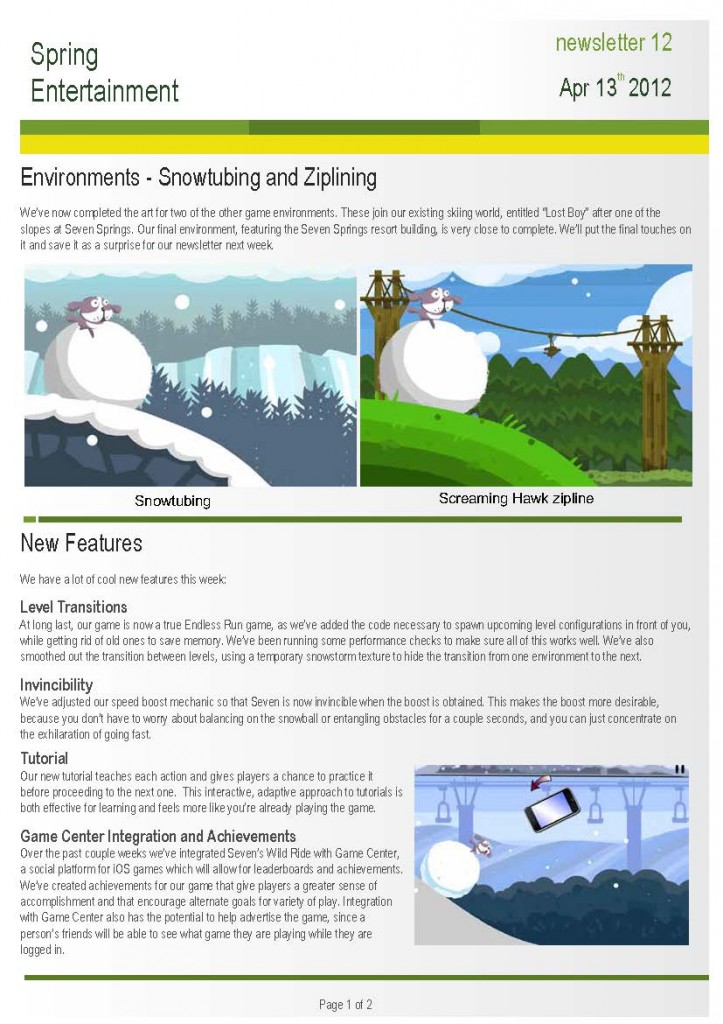Newsletter #12
Environments – Snowtubing and Ziplining
We’ve now completed the art for two of the other game environments. These join our existing skiing world, entitled “Lost Boy” after one of the slopes at Seven Springs. Our final environment, featuring the Seven Springs resort building, is very close to complete. We’ll put the final touches on it and save it as a surprise for our newsletter next week.
New Features
Level Transitions
At long last, our game is now a true Endless Run game, as we’ve added the code necessary to spawn upcoming level configurations in front of you, while getting rid of old ones to save memory. We’ve been running some performance checks to make sure all of this works well. We’ve also smoothed out the transition between levels, using a temporary snowstorm texture to hide the transition from one environment to the next.
Invincibility
We’ve adjusted our speed boost mechanic so that Seven is now invincible when the boost is obtained. This makes the boost more desirable, because you don’t have to worry about balancing on the snowball or entangling obstacles for a couple seconds, and you can just concentrate on the exhilaration of going fast. Snowtubing Screaming Hawk zipline
Tutorial
Our new tutorial teaches each action and gives players a chance to practice it before proceeding to the next one. This interactive, adaptive approach to tutorials is both effective for learning and feels more like you’re already playing the game.
Game Center Integration and Achievements
Over the past couple weeks we’ve integrated Seven’s Wild Ride with Game Center, a social platform for iOS games which will allow for leaderboards and achievements. We’ve created achievements for our game that give players a greater sense of accomplishment and that encourage alternate goals for variety of play. Integration with Game Center also has the potential to help advertise the game, since a person’s friends will be able to see what game they are playing while they are logged in.
Test Flight
After halves, we began using TestFlight to share builds of our game. TestFlight is an online service that allows us to distribute our build to specific people and devices for testing, gather feedback from users, and collect some very basic metrics, such as time spent in the game and level reached.
We’re gearing up for testing now, in a low-key way with a few people outside our team. Around the time of our Soft Opening, which is April 23rd, we’re also hoping to use TestFlight to distribute the game to a slightly larger pool of testers.
If you have an iPhone or iPad and would like to be a tester, or if you would like to recruit other testers for us, you can pass along our recruitment URL, through which people can register as part of our TestFlight testing team: http://tflig.ht/IGtyuD
Third Internal Playtest
Today the Spring Entertainment team held an open house playtest. ETC faculty, staff, and students came by to try out the latest version of our game. Having faculty and staff in addition to just students was very helpful for us, since we are trying to make a game that is playable by a wide range of ages and prior game experience.
Our most important new feature for this playtest was our tutorial, which mostly worked well. Giving players the chance to practice the same action over and over until it made sense made a huge difference in their success when they went into Level 1, compared to our players last week.
We did discover some ways that the tutorial could be even stronger with fine tuning. For example, a common point of surprise among playtesters is how obstacles entangle in the snowball. People naturally expect to jump over obstacles as they lie on the ground, because that is the more common convention in games. Once people understand how our obstacles work differently, they usually do fine, but it is helping them have that revelation that is the challenge. Based on what we saw in playtesting, we think a huge step toward achieving this would be to give the player some kind of “Ready…Tap!” indicator when learning to jump. Right now, the tutorial just indicates the moment when you should “Tap!” (actually, we use a timed image of a tapping finger). If we can help players understand that there is a delay compared to what you would normally expect to do (via an image that indicates “Ready…”), we think we can make this mechanic more intuitive.
While we weren’t able to include it in our playtest this week, we’ve also made an easier Level 0 that will play after the tutorial any time the tutorial is turned on. This allows new players to cut their teeth on something less intense, while still allowing more experienced players who are revisiting the game to jump in at a slightly more appropriate level of challenge.
Overall, our survey results indicate that our testers this week found the game more fun and less frustrating overall than last week, so while we still have work to do in tweaking our difficulty curve, we are headed in the right direction.

